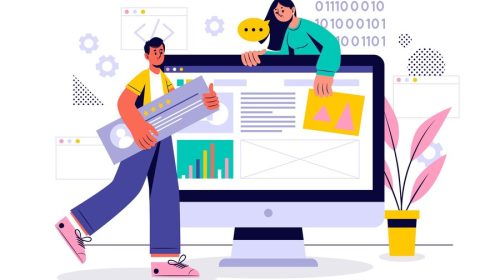Every year the requirements for education change, new tools and techniques appear, and the old principles cease to work. What interesting will happen in 2020? Will there be a technological replacement for desks, boards and teachers? Our company experts, using the example of foreign training, examined which areas will develop in the new year.
Table of Contents
What is meant by digital education?
Digital education is the use of technology to deliver and enhance educational opportunities. It encompasses a broad range of tools and technologies, including e-learning, online courses, digital textbooks, educational apps, and virtual classrooms.
Digital education has become increasingly important in recent years, as technology has advanced and become more accessible. It provides students with flexible learning options, enables them to learn at their own pace, and provides access to a wealth of educational resources from anywhere in the world.
What is the purpose of digital education?
The benefits of digital education include improved student engagement, greater access to educational opportunities, and the ability to deliver personalized learning experiences that cater to individual needs and learning styles. It also provides educators with new tools and methods for teaching, enabling them to create dynamic, interactive learning experiences that are more engaging and effective than traditional methods.
However, digital education also comes with challenges, such as ensuring equal access to technology and internet connectivity, maintaining student privacy and data security, and providing adequate training and support for educators and students.
Overall, digital education has the potential to transform the way we learn and teach, providing a more accessible, personalized, and engaging educational experience for learners of all ages and backgrounds.
MINDFULNESS SKILLS TRAINING SINCE CHILDHOOD
Behavioral and emotional disorders have become epidemic in different countries. Anxiety, depression, or attention deficit hyperactivity disorder is diagnosed in schoolchildren more often than ever.
Every day, children and adolescents struggle to figure out how to fit into this complex and fast-paced world, while struggling with things like intense pressure at school, bullying, or problems at home. And this is against the background of social networks that broadcast a vibrant and successful peer life.
Why is digitization of education important?
A study commissioned by the British National Health Service in 2017 found that one in eight children in England 5-19 years old suffered from at least one mental disorder. As a result, in early 2019, the British government announced the launch of a new pilot project.
They work with experts and learn meditation, relaxation techniques and breathing exercises to learn how to regulate their emotions on their own.
Awareness enhances peace of mind, reduces depression and helps fight anxiety. According to Dr. Jessica Dayton of University College London, who leads state trials, such lessons will not only help you feel better in the short term, but also prepare children for the challenges of later life.
VIRTUAL AND AUGMENTED REALITY (VR / AR) IN THE CLASSROOM
Virtual and augmented reality technologies are currently at the peak of development. According to the forecasts of the analytical company IDC, the market will reach $ 5.5 billion in 2023.
Many of the developments have been successfully applied in the field of education. Teachers and students study different disciplines with devices that support AR and VR.
In order for the students to study the place in advance, in an environment with a low level of stress, they created a virtual tour for them: a tour of the classrooms and corridors.
School St. John’s School in Boston uses virtual reality to create experiences. Pupils ride a roller coaster, walk in an amusement park, drive a car – and this is from the walls of the school library.
The guys from the Mendel Grammar School in the Czech Republic, using VR controllers, conduct biological and chemical experiments. For example, they penetrate the human eye and manipulate parts of it to understand how they work.
THE OPPOSITE WAY – GIVING UP GADGETS
While some schools are introducing more and more technology into everyday school life, others are trying to maintain digital detox. In 2018, the ILAC language provider launched the Zero-Tech pilot project at its centers in Toronto and Vancouver. Following in the footsteps of digital giants such as Apple and Facebook, which acknowledge the dangers of excessive freezes on screens, ILAC asks students and teachers to disconnect from the network. And it’s not just about mobile phones – no smart boards and laptops.
Also Read : What are the most important tools for digital marketing
MORE DEEPENING IN PROJECT TRAINING
Gone are the days when students passively sat at their desks, and teachers endlessly lectured, expecting the children to absorb theoretical information.
Today, in the educational environment, students must collaborate, think critically and work together to develop projects and find answers to complex questions.
Project Based Learning (PBL) allows teachers to introduce students to new information and develop the skills needed in the 21st century, and students to interact with the program in a fun and authentic way.
Encode the robot using your own phone, help local entrepreneurs improve environmental sustainability and reduce waste, write and publish their own book – for each discipline in an overseas school, active design work is provided.
THE EMERGENCE OF ROBOT TEACHERS IN THE CLASSROOMS
Robots are increasingly used abroad to teach students in the classroom, especially in the natural sciences, mathematics, and languages. While they are more used as tools, rather than independent units.
The humanoid robot Robin is part of a European research project whose goal was to teach young children a second language (English) using social robots. For two years, 208 Dutch-speaking preschoolers aged 4–6 years participated in the study.
What is the impact of digital education?
And some work with children with special needs. For example, a doll-like Caspar robot helps teachers and parents support children with autism or other communication problems. Although its ghostly appearance may seem creepy, Caspar was deliberately designed with a minimally expressive face, because autistic children often have trouble reading facial expressions and interpreting voice tones.
The above trends in education are just one of the few. Technology is in the hands of minors. They use them from early childhood and quickly adapt their lifestyle to them. Therefore, schools and educational approaches must also respond quickly to changing world conditions.











